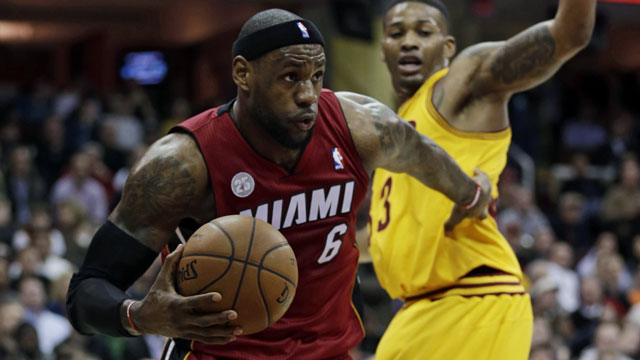You don’t actually need me to tell you why the Miami Heat are going to win the title this year, do you? I mean, they’ve got LeBron. They won last season going away. Nuff said. I’ll just type out the first 700 words or so of The Great Gatsby and call it a day:
In my younger and more vulnerable years my father gave me some advice I’ve been turning over in my mind ever since. “Whenever you feel like criticizing any one,” he told me, “just remember that all the people in this world haven’t had the advantages that you’ve had.”
OK fine. Right now, one online sports book is offering 5–7 odds on Miami repeating as champs (meaning you bet seven bucks to win five), an unheard-of line considering the fact 15 other teams remain in the running—for comparison’s sake, the Thunder have the next-best odds and they’re currently a 9–2 shot. The reason for this is pretty plain: LeBron James and Co. currently have just about every advantage imaginable over the rest of the NBA. They look even better than they did this time last year, and they’re going to make the playoffs look academic.
Any talk of Miami’s chances needs to begin with “the streak.” Starting in Toronto on Feb. 3, Miami ripped off 27 straight wins—the second-best run ever, behind the ’71–72 Lakers’ 33 consecutive wins. Though it’s the gutsy fourth-quarter comebacks that stand out, more often the Heat blew out their opponents, putting up a plus-11.9 margin of victory over the stretch. And it’s not just how many they won or by how much, but who they beat—the Clippers, Lakers, Grizzlies, Hawks, Knicks, Celtics, Rockets and, yes, the Thunder among them.
You could try to play down the streak, but the reality is the Heat have been the most efficient offensive team in the league according to Hoopdata.com. They’ve put up 102.9 points per game (fifth in the NBA) despite playing at the league’s 24th-fastest pace and lead all teams in true shooting percentage and effective field-goal percentage, two metrics weighted to better account for three-point and free-throw shooting. That efficiency is due in no small part to another MVP-calibre season from James. He’s hitting career highs in field-goal percentage and rebounding, and nearing a personal best in player efficiency rating at 31.69 (the league average is 15). He also had that little streak of his own—six straight games with at least 30 points and 60 percent shooting, a first in NBA history. He’s also taking fewer shots from 10–23 feet in favour of post-ups and shots at the rim (where he’s making a ludicrous 77.7 percent).
And it’s not just James. Or Chris Bosh and Dwyane Wade, though the latter has been playing as well as ever since a shaky November. Truth is, this team is no longer the wobbly, top-heavy beast it was. The 2010–11 Heat ran into trouble when opponents packed the lane, but this iteration doesn’t allow that to happen. Coach Erik Spoelstra’s system has Miami whipping the ball around the floor to find open three-point shooters in the corners. This is all possible thanks to the personnel moves made since James and Bosh came aboard in the summer of 2010. Shane Battier (signed in 2011) and Ray Allen (who bolted Boston last summer) are each shooting better than 42 percent from downtown and keep defences extremely honest, punishing them when they falter.
On the other side of the ball, the Heat rotate and help in those same situations as well as anyone, making up for their lack of a paint-clogging, shot-blocking post presence by covering crazy amounts of ground with their length and athleticism. They’re a decidedly subpar rebounding team (ninth-worst in rebound rate, dead last in rebounds per game), but they remain a stout defensive unit on the whole. In fact, the team gave up 100 points in regulation just five times during the 27-win streak and sit at eighth in defensive efficiency for the season.
What’s more, no other team benefits as much from the typically shortened rotations of the playoffs. Spoelstra gets to play his big three for a full 48 if need be, and his big three are young and resilient enough to be effective from the opening tip to the final buzzer. (Case in point: James played all but 20 minutes of last year’s finals, and three of those were spent dancing on the sidelines once the series had been sealed.) Oh yeah, the team also happens to be as healthy as any in the league, and a whole lot healthier than they were this time last year when Bosh sat out most of the second and third rounds with an oblique strain.
Love ’em or hate ’em, the Heat are the best team in the NBA, and somehow they’re still getting better. June’s finals are going to look like a rerun of last year’s—the only thing yet to be determined is the colour of the jerseys on the losing team. Ahem.
So we beat on, boats against the current, borne back ceaselessly into the past.
